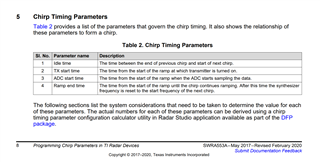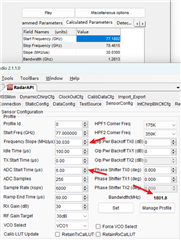Tool/software:
Hi ! Maybe I misunderstood. Could you help me analyze in detail the impact of two parameters on the mixer?

In the figure, TX START TIME controls the transmission of the antenna, while ADC START TIME controls the sampling process. The reference signal in the mixer is the same as the transmission signal. Due to the configuration of ADC START TIME, the starting frequency domain of ADC sampling is different from the transmission signal. Will this not cause distance errors? Is it compensated by internal components?
For example, the settings for SensorConfig are as follows. The start frequency is 77(GHz)+30.03(MHZ/us)*6(us) = 77.18(GHz). Due to the Tx start time setting, the frequency of the transmitted signal is less than 77.18GHz.Could you tell me the starting frequency of the transmitted signal and the reference signal in the mixer at this time?

Thanks!

